Description
Henri Matisse, one of the most prominent artists of the 20th century, presents us in "Marguerite Ad Antibes" from 1922 a moving amalgam of colors and shapes that capture the essence of his Fauvist style. The work, which measures 72x60 cm, opens a window to the serenity of a corner of southern France, specifically Antibes, with a masterful execution in the use of color and form.
In this painting, Matisse portrays Marguerite, his daughter, sitting in a highly decorated interior space. Marguerite's figure becomes the core of the work, a focal point from which a visual symphony unfolds. Matisse uses vibrant chromaticism that reflects his ability to harmoniously combine warm and cool tones. The intense and bold colors, characteristic of Fauvism, are fully lived in this painting, where blues, reds, and greens are in constant dialogue.
The artistic composition of "Marguerite Ad Antibes" is of subtle yet deliberate balance. The silhouette of Marguerite, outlined with firmness but softness, reminds us of Matisse's impressionist influences, without losing the distinctive mark of Fauvism that made him one of its main exponents. The intricate background seems to embrace the central figure, with patterns and textures distributed almost musically, creating an atmosphere of warmth and tranquility.
It is remarkable how Matisse manages to capture not only the physical image of his daughter but also a deeper and more emotional essence. Marguerite is not simply posing; her presence has a contemplative aura, immersed in her thoughts, which adds a layer of intimacy and psychological depth to the work. This is a testament to Matisse's mastery in endowing his characters with an emotionality that transcends the canvas.
Antibes, with its Mediterranean light and bucolic landscape, is a recurring setting in Matisse's work. This place not only represents a physical environment but also a state of peace and retreat that the artist knew how to exploit to heal and find inspiration. The choice of tones and the structure of "Marguerite Ad Antibes" suggest a symbiosis between the natural environment and the human figure, where each element complements and enhances the other.
"Marguerite Ad Antibes" is, without a doubt, a work that encapsulates Matisse's artistic evolution. From the chromatic audacities of Fauvism to a more personal and emotional representation, this piece is a testament to his ability to innovate and, simultaneously, maintain a deep connection with his subjects. This painting not only stands out in his repertoire for its visual beauty but also because it reflects an integral part of his personal and affective life.
Ultimately, Henri Matisse invites us to a visual and emotional journey through "Marguerite Ad Antibes", where each brushstroke and each color speaks of family love, serenity, and the extraordinary ability of the master to find beauty in the everyday. This work remains an enduring testament to Matisse's greatness in the world of modern art.

